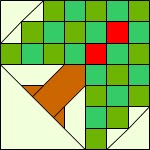Tea Leaf by Becky Brown
The Tea Leaf block can remind us of Dixie and Confederate coffee substitutes during the blockade.
Sassafras Leaf
Mary Mapes Dodge in an 1888 story Two Little Confederates painted a picture of the limited treats her two main characters enjoyed during the war:
"There was no sugar nor coffee nor tea. These luxuries had been given up long before. An attempt was made to manufacture sugar out of the sorghum, or sugar-cane, which was now being cultivated as an experiment; but it proved unsuccessful, and molasses made from the cane was the only sweetening.... Sassafras-tea was tried as a substitute for tea, and a drink made out of parched corn and wheat, of burnt sweet-potato and other things, in the place of coffee; but none of them were fit to drink — at least so the boys thought."
Sassafras tea made from roots and bark has long been a home-brewed beverage. It's the traditional flavor in root beer, and so much a Southern staple that a reference to "cinnamon seed" or sassafras tea is found in older versions of the song "Dixie", the unofficial Confederate anthem.

Dan Emmett from Ohio published
many tunes such as "Turkey in the Straw."
"Dixie's" tune and lyrics were probably a folk tune sung for decades before it was actually published before the war in 1859 as a commercial minstrel tune. The lively melody became popular in the North and was a favorite of Lincoln. While "John Brown's Body" became a Union anthem, "Dixie" became a Southern marching song.
The chorus is generally sung as:
Oh, I wish I was in the land of cotton,
Old times there are not forgotten,
Look away, look away, look away Dixie Land.
An earlier version substitutes a reference to sassafras tea and catfish fishing in the second line
Oh, I wish I was in the land of cotton,
Cinnamon seed and sandy bottom,
Look away, look away, look away Dixie Land.
Soldiers on both sides invented numerous versions and as the word Dixie increasingly became a nickname for the South, patriotic versions were published, such as this 1861 “Dixie War Song.”
Southrons, hear your country call you,
Up, lest worse than death befall you!
To arms! To arms! To arms, in Dixie!
This week's block is #1735 in BlockBase, one of many variations on this nine patch. Pattern designers saw it as a tea leaf, a poplar leaf, a magnolia leaf and an a maple leaf, among other flora and fauna.
Cutting an 8" Finished Block
A- Cut a strip 1" x 5". You'll trim this later.
B- Cut 1 background square 3". Cut into 2 triangles with a single diagonal cut.
C -Cut 3 dark and 1 background squares 3-1/8"
D- Cut 2 dark and 2 background squares 3-1/2". Cut each into 2 triangles with a single diagonal cut. You need 4 dark and 4 background triangles.
A tea leaf quilt from about 1880-1910
at the Red and White Quilt Show in
New York last spring.
Hear a 1916 version of the minstrel song "Dixie" by the Metropolitan Mixed Chorus on YouTube by clicking here:









































